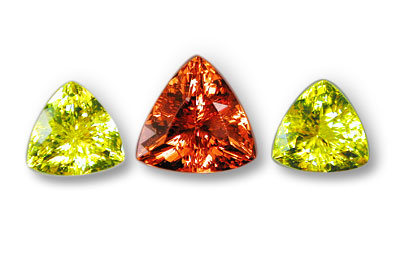
By Gordon Smith
Reprinted from the San Diego Union-Tribune, Sept. 7, 1992
Note: After many years at Pala International, Meg Berry left to pursue gem carving full time. All of us at Pala wish her every success in her new venture.
So here was Meg Berry, champion bicyclist from Vista [CA], mother for only seven weeks, called in from maternity leave for the biggest job of her life: cutting a 26-carat emerald that was unearthed by ancient Indians in Colombia, dispatched to Spain by the Conquistadors, sunk in hurricane and lost on the ocean bottom for the last 370 years. Value? About $250,000. No sweat. Twelve hours later, the rough stone was a glittering gem, the color of a mountain stream. Soon it will adorn the neck of Deo Fisher, the wife of treasure hunter Mel Fisher, whose Salvors Inc. found the uncut emerald in the wreck of the Spanish galleon Nuestra Señora de Atocha six years ago off the Florida coast. And Meg Berry – who is also a master gem faceter – will go back to cutting and polishing tourmaline and other precious stones for The Collector, a gem dealer in Fallbrook. “This emerald is the most valuable rough gem I’ve ever cut,” said Berry. There’s always a chance that a stone will crack or even explode while it’s being faceted, she pointed out. But in the gem-cutting business, Berry added, “You can’t afford to be nervous.”
There’s always a chance that a stone will crack or even explode while it’s being faceted, she pointed out. But in the gem-cutting business, Berry added, “You can’t afford to be nervous.”
The Collector got the chance to work on the emerald because of past gem-cutting the company has done for Treasure Group International, a company that markets the $400 million treasure of the Atocha. Berry, 37, was tapped to facet the stone last week because “she’s so good. She has an enormous amount of experience,” said Josh Hall, Vice President of Pala International, parent company of The Collector. Berry said she began by holding the rough, translucent green crystal up to the light, contemplating how to cut it to produce a gem with the best possible clarity and color. “You have to visualize the finished stone inside there,” she said. Then, while here daughter Hannah slept in an infant’s swing nearby, Berry began “cutting” the first facet by grinding the emerald on a faceting machine. Other facets followed – 69 in all – each at a precise angle.
 |
| This outstanding suite of two canary-yellow tourmalines from Malawi, along with a fine Nigerian spessartine garnet (center), won Meg Berry yet another award, this one in the 2002 AGTA Cutting Edge contest. Photo: Wimon Manorotkul; Gems: Pala International |
In the small community of experts who cut colored precious stones – there are less than 100 such master faceters nationwide, Hall said – Berry has won first-place awards in industry cutting competitions each of the last two years. If the facets are cut too flat, light is reflected out the sides of the finished gem instead of the top, and it lacks sparkle, Berry explained. If the facets are angled too steeply, light bounces around inside and the stone seems dull or dark. Usually at least 60 percent of an emerald is turned into unusable dust in the faceting process.
In the small community of experts who cut colored precious stones – there are less than 100 such master faceters nationwide, Hall said – Berry has won first-place awards in industry cutting competitions each of the last two years.
But Berry used all her skill to grind away only 51 percent of the original stone from the Atocha, winding up with a 12.72-carat jewel. After cutting the gem, she went back and polished each of its 69 surfaces – twice. You have to be a little obsessive to stick with the close, eye-crossing work hour after hour, Berry concede. “You have to focus. You have to concentrate,” she said. “But once you have the experience,” she added – and she has 18 years of it – “you’re OK.” For now, Berry will continue to cut other gems and pedal her racing bike around the velodrome in Balboa Park whenever she can. She’s a defending national champion velodrome rider, she said. But there could be other emeralds in her future. Only five pounds of an estimated 70 pounds of emeralds on the Atocha, which sank in 1622, have been recovered. That leaves about 147,000 carats waiting to be found. Salvage work on the wreck continues.